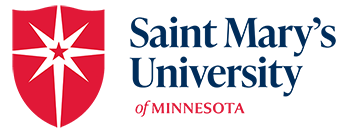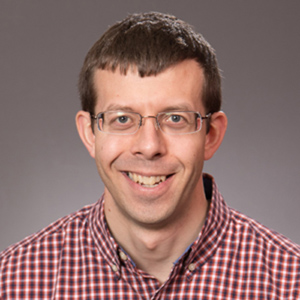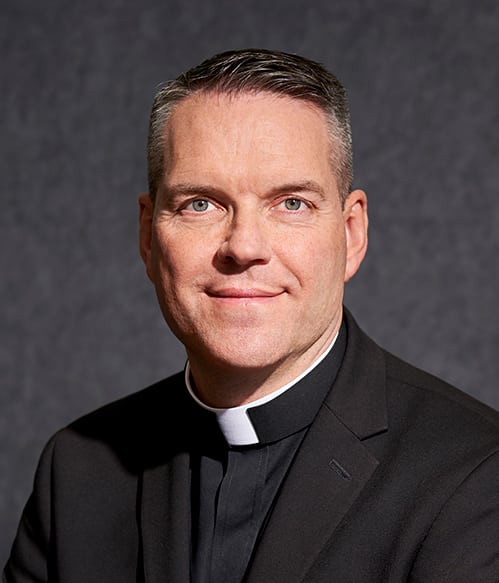Saint Mary's Newsroom
Campus ConnectionAn update from the president to alumni and parents
Remote writing support
During the suspension of in-person classes, students at the College now have two options for remote writing support: Through shared Google Document and follow-up phone or email conversation.
To submit your paper to a Writing Studio tutor via shared Google Doc:
- Make an appointment at least three hours in advance by visiting the Writing Studio website at writing.smumn.edu/writing-studio. Select “Sign up for a Writing Studio appointment.”
- Share your paper and your writing assignment description with your tutor on Google Drive before your appointment time. For instructions on how to use Google Drive, please see our Guide to Writing Support.
- Be available during your appointment time for your tutor to call you with questions, to clarify your assignment, and to explain suggestions for revision. Appointments will be made in one-hour blocks. During that time, your tutor will read your paper, make comments, and ask questions. The tutor will call you before the end of your appointment time to discuss your paper.
- Please complete a brief satisfaction survey that you’ll receive via email after your appointment.
To get written feedback from a writing consultant via email:
- Visit the Writing Studio website at writing.smumn.edu/writing-studio. Select “Sign up for an online email review.” This will take you to the submission form.
- Answer the questions about what you need help with, then submit a Microsoft Word version of your paper and your assignment description at the end of the form.
- A writing consultant will email you written feedback by the date requested. Please allow a minimum of 24 hours.
- You can submit your paper anytime, including weekends.
Mailroom updates
USPS mail
Since Saint Mary’s University is considered a business, students are unable to complete the change of address form with the United States Postal Service. We are advising students to reach out to their mail contacts (i.e., financial institutions, magazine subscriptions) directly to change their address on file.
Mail currently in mailboxes
The mailroom will forward personal first-class mail to your home address on file, unless you have provided a different mailing address. If you have a different mailing address, please contact the mailroom at mailroom@smumn.edu by Friday, April 3. We will not forward magazines, junk mail, or campus mail.
For returning international students, the mailroom will create mail packages for you to retrieve from the International Center upon your return.
Packages
Starting Wednesday, April 1, Saint Mary’s will no longer accept student packages, except packages designated for those students who are currently residing at the Alverna Center. Per policy, UPS and FedEx do not forward packages. The USPS permits package forwarding on select parcels and will charge postage due upon receipt.
Any packages that cannot be forwarded will be held until students can return to campus and retrieve their personal items. Students who wish to return packages to sender or forward will need to make the appropriate arrangements and provide the mailroom with the shipping label.
Spiritual offering
Saint Mary’s Campus Ministry continues to share spiritual offerings to provide much-needed perspective and a focus on faith in this time of uncertainty.
“No, in all these things we are more than conquerors through him who loved us. For I am convinced that neither death nor life, neither angels nor demons, neither the present nor the future, nor any powers, neither height nor depth, nor anything else in all creation, will be able to separate us from the love of God that is in Christ Jesus our Lord.” – Romans 8:37-39
Find more resources, including prayer cards, from the United States Conference of Catholic Bishops.
Crisis and risk communication with refugee and immigrant communities

Farhiya Farah, Ph.D.
Farhiya Farah, Ph.D., program director for the Master of Public Health, has been working with Somali populations in the Twin Cities area to promote public health actions and improve communications. This article details how public health promotion of social distancing aimed at reducing the impact of COVID-19 requires a crisis communication strategy aware and respectful of deeply entrenched values and norms of the targeted community.
By: Farhiya Farah, Ph.D.
COVID-19 has ushered the world into a precarious predicament demanding urgent interventions and community mobilization to successfully contain, mitigate, or suppress the spread of the virus. Numerous models have emerged simulating infection course trajectories examining the consequences of various intervention policies (Neil, 2020; Childs 2020; Kucharski 2020). However, model inputs and assumptions assume a uniform application of intervention policies and homogenous human behavior. Similar models using different target populations considering their unique attributes would yield starkly different infection spread outcomes.
Human behavior is extremely complex, with many factors contributing to public health intervention observance. It’s important to remember how intervention adherent subtleties could result in profoundly different outcomes, most often unfavorable, and especially with disenfranchised communities. Immigrants and refugees are often from such a community.
For example, crisis communications pertaining to social isolation directed to the refugee and immigrant community. The direction is to keep a 6-foot distance from one another, preferably accomplished by staying home and reducing non-essential trips. A homogenous society with the same cultural tendency would perhaps respond in a like manner to this directive. Unfortunately, this is not the reality of our heterogeneous society.
Health communication is the quintessential influencing tool of public health in promoting health and preventing diseases. The Centers for Disease Control and Prevention describes health communication as the vehicle “to inform and influence individual and community decisions that enhance health” (CDC 2020). Health communications experts have long recognized the success of health communication campaigns dependent on the dynamics of ‘interpersonal, group, organizational…” for effective health messaging (Kreps, 2008).
We can use the Somali community as an example. The Somali cultural concept of personal space is starkly different from mainstream America, as the cultural application of social distancing is gender-dependent. Most Somali interactions are typically tightly nested, infiltrated by hugs, cheek kissing, and kisses on the hands or heads of elders. Therefore, the public health promotion of social distancing aimed at reducing the impact of COVID-19 requires a crisis communication strategy aware and respectful of deeply entrenched values and norms of the targeted community. Moreover, the majority of the Somali community’s deeply-seated fatalistic attitudes negatively impacts reception to preventive messages if proper measures are not taken to respectfully address it. Considering the messaging urgency of COVID-19, public health and health care providers must be aware of the practical guidelines available, informed by the theoretical foundation for successful crisis communication with new Americans.
Below is a summary of such guidelines helpful for public health professionals to implement during the current pandemic. These guidelines are adapted from the 10 crisis and risk communication tips for public health professions working with native and new Americans (Littlefield, 2007).
- Involve multicultural specialists in communicating about public health risks.
- Use cultural agents as links to multiple communities.
- Take time to build relationships with multiple communities before the crisis.
- Utilize different ways to listen to and become involved with different communities.
- Realize that views about a public health crisis vary across cultures.
- Be mindful of religion and culture when communicating about risks with multiple communities.
- Be mindful about cultural learning styles when communicating about risks with multiple communities.
- Be mindful of literacy levels when communicating about risks with multiple communities.
- Be sensitive to cultural groups’ feelings about disclosing information and talking with public health agencies and officials.
- Exhaust the ways to communicate what you learn about cultural groups with other cooperating agencies.

16th annual Doctoral Research Symposium highlights student work
More than 140 doctoral students, faculty, and program alumni from across Saint Mary’s doctoral programs, including Psy.D, Ed.D., and D.B.A., gathered on the Twin Cities Campus for the 16th annual Doctoral Research Symposium on March 7. This full-day event highlighted student work, both in progress and after completion. Sessions included poster presentations of studies still in the design stage and breakout presentations of completed dissertations and research projects, along with networking opportunities throughout the day. Students received feedback on their work and shared thoughts across disciplines.
Topics under investigation included:
- “Dismissing a supervisee: The experience of the clinical supervisor”
- “The influence of customer’s senses on sensory marketing”
- “Integrating career readiness: Core subject teachers’ experiences of partnering with industry professionals”
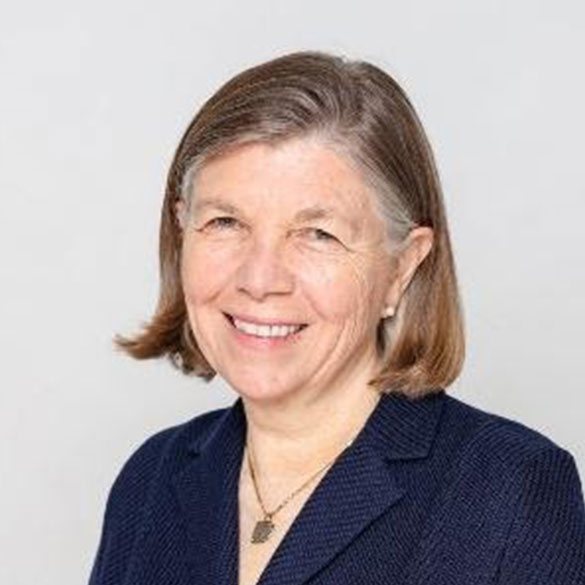
Dr. Karen Shields-Wright
The keynote speaker, Dr. Karen Shields-Wright, presented Answering the Call: Creating Your Vision as a Servant Leader in Serving the Common Good, in which she illustrated the use of principles of Catholic social teaching as an ethical model and reflective practice for academic work, personal growth, leadership, and service.
Other highlights included an Ed.D. comprehensive examination workshop, a session on navigating the Institutional Review Board (IRB), a faculty presentation on becoming adjunct faculty, and an Ed.D. dissertation defense, demonstrating the completion of one student’s doctoral journey.

Four students share research with legislators at the Minnesota Capitol
Four Saint Mary’s students presented their research for Scholars at the Capitol March 11. These students had a chance to engage with several lawmakers, who asked to review their research papers. A legislator also asked one of the students to potentially testify at a committee meeting related to a proposed bill.
Junior Samantha Chaffee, junior Huy Truong, and senior Nayeli Hernandez Moctezuma — advised by Dan Bucknam, Ph.D., assistant professor of Psychology, — presented “The Convenience of Modern Technology: The Relationship Between the Excessive Use of Technology and Physical Well-Being.”
Their study examined the perception of technology usage and its relationship with psychological well-being. The students’ research established significant correlations between screen time and stress, happiness, and depression. Their results support the established relationship between screen time and psychological well-being and provide insight into the relationship between the perceived interference of screen time and psychological outcomes.
Senior Solomon Liebl presented “The Effects of Financial Stress and Financial Education on College Students.” Advised by Andrew Scott, assistant professor of Business, Liebl investigated existing research surrounding college students’ financial welfare and the effects of financial education. Liebl’s research shows that high levels of student loans contribute to student financial stress, which can influence academic performance and retention. Further research has indicated that implementing targeted financial education classes and offering financial counseling will help decrease students’ financial stress. In summary, Liebl suggests that universities may encounter positive benefits from investing in financial education programs.
Photo caption: Saint Mary’s students with Senator Jeremy Miller (center).
Faculty member publishes two pieces
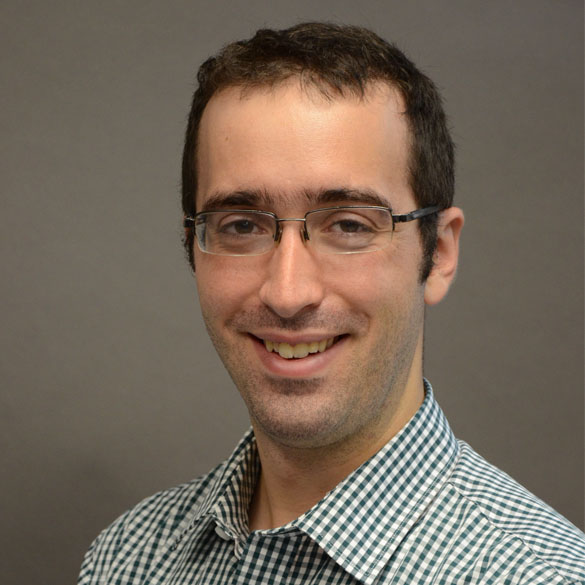 Christopher Jordan, Ph.D., assistant professor of Chemistry, recently published two scholarly articles, one of which was co-authored with four Saint Mary’s students:
Christopher Jordan, Ph.D., assistant professor of Chemistry, recently published two scholarly articles, one of which was co-authored with four Saint Mary’s students:
“Lasallians in the Lab: The Distinctively Lasallian Character of Undergraduate Research,” was published in AXIS: Journal of Lasallian Higher Education. The article describes the importance of undergraduate research in Lasallian education. The participation of undergraduates in scholarly research is an essential part of higher education in the sciences, but its connection to the Lasallian mission has not been described in detail. Dr. Jordan wrote this as his Capstone reflection at the end of his participation in the Brother John Johnston Institute of Contemporary Lasallian Practice, a formation program that brings Lasallians from across the country together to build a deeper appreciation of the Lasallian charism.
“Features of Vibrational and Electronic Structures of Decavanadate Revealed by Resonance Raman Spectroscopy and Density Functional Theory,” was published in The Journal of Physical Chemistry Letters. Dr. Jordan’s four co-authors were all Saint Mary’s students: Paula Avila ’18, Thomas Ripplinger ’17, David Kemper ’19, and Joseph Domine ’18. This article demonstrates how a combination of experimental and theoretical tools can be used to better understand the strength and arrangement of chemical bonds in decavanadate, which is a potential therapeutic because of its antibacterial, antiviral, and anticancer properties. In the future, Dr. Jordan plans to extend his work with Saint Mary’s undergraduates to see if the same techniques described in this article can help us study the decavanadate-enzyme relationship.
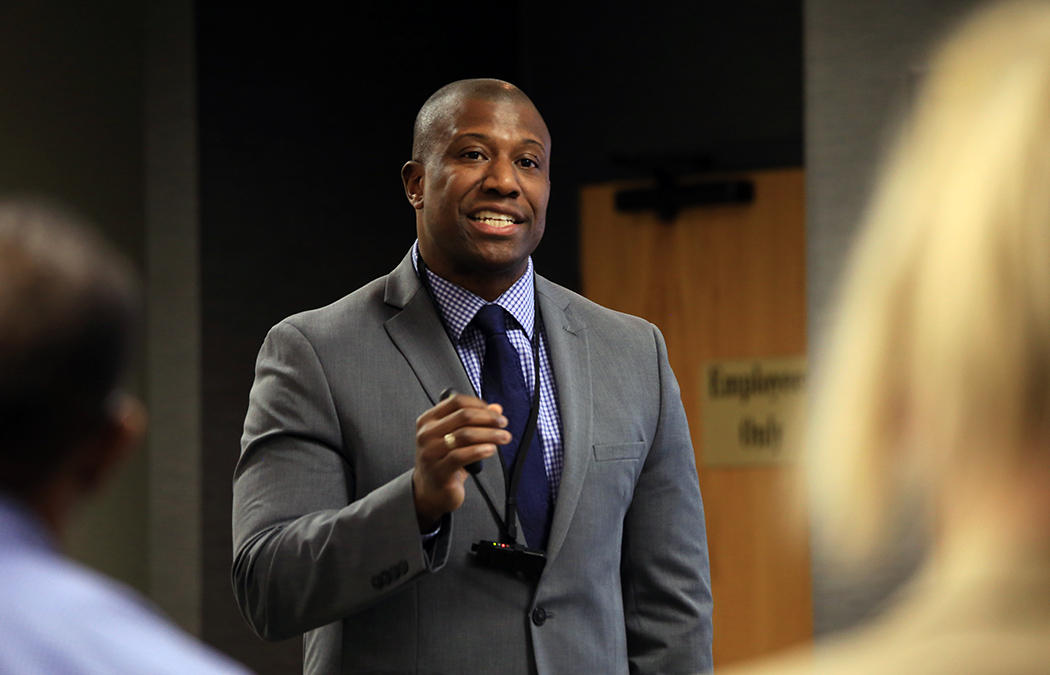
Ed.D. graduate, former police officer examines use-of-force training throughout Minnesota
When it comes to looking at the interactions between police officers and civilians, especially those made in extremely stressful situations, Shawn Williams D’19 knows it is too easy to only look at the statistics and draw conclusions. That’s not the full picture.
Dr. Wiliams is very familiar with these statistics after serving as a police officer for 17 years, including tenures with the Bloomington and Minneapolis police departments. He spent a collective 16 years assisting or leading use-of-force training for new police recruits in various capacities. According to the National Institute of Justice, use-of-force tactics refer to the “amount of effort required by an officer to compel compliance by an unwilling subject.”
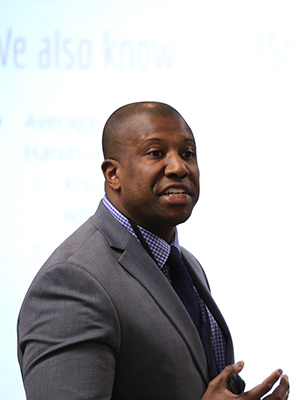
Dr. Shawn Williams served as a police officer for 17 years, including time with the Minneapolis and Bloomington police departments in Minnesota.
Through his own experiences, Dr. Williams knew gaps in research and training existed at nine Minnesota training facilities, which provide training to all new police recruits.
Dr. Williams, who recently earned his Doctorate of Education in Leadership at Saint Mary’s University, presented the findings of a phenomenological, comparative study of practices throughout the state of Minnesota on March 7 titled “Split-Second Decision Making in Police Use-of-Force Training.”
“I didn’t want to use statistics,” Dr. Williams told the crowd. “I wanted to hear what law enforcement personnel are doing in their own training facilities to assist future officers with being competent, efficient, and using force only when need be.”
His study demonstrated the need for uniformity of initial use-of-force training across the state’s training facilities, something that nearly every other state has, as well as the U.S. military.
“There’s a solid base layer of training that most programs have that we in Minnesota currently do not have,” Dr. Williams said.
In addition, Dr. Williams’ research highlighted the collective confusion that resulted from the use of one word in particular: proficiency.
All training centers in the state follow the objectives formed by the Minnesota Board of Peace Officer Standards and Training (POST), which has the following general learning goal: “The officer will demonstrate proficiency and explain the importance of unarmed control measures, which are authorized by the officer’s agency.”
“The POST board uses the word proficiency, but does not define what they mean by the word proficiency,” said Dr. Williams, who teaches law enforcement classes as an assistant professor of criminal justice at St. Cloud State University, as well as serves as the school’s professional peace officer education program coordinator.
His research formed the nucleus of his doctoral dissertation, which he defended in July 2019 with Yvette Pye, Ph.D., as his dissertation adviser. Dr. Pye commended Dr. Williams’ end goal to help his industry and the community.
During a seven-month period that began in 2018, Dr. Williams interviewed three veteran use-of-force instructors located at three of the four largest training centers in Minnesota based on recruits trained. The instructors had an average of 23 years of experience as police officers before leading the training at their facilities. He asked the same questions to a veteran military combatives instructor, who had 16 years of military experience, including six deployments. The interviews were recorded on video, transcribed, shown to the interviewees, and then coded.
The interviews were reviewed and analyzed using the qualitative data analysis software NVivo to determine the words that were used the most. Several themes emerged, including subjective trainer qualifications, styles of instruction, and hours allotted for training dictated by organizations rather than trainer input.
Per POST guidelines, all recruits receive 64 to 80 hours of use-of-force training, as dictated by the institution in which the skills program is located. But this is not always enough time for trainees to reach the skill level that society expects.
Dr. Williams has begun the initial steps of a follow-up quantitative study to survey the approximate 10,900 police officers in Minnesota to assess their overall confidence in the use-of-force training they received.
Gaining a new perspective
Dr. Williams began the Ed.D. program at Saint Mary’s in 2014 while working as a member of the SWAT team for the Minneapolis Police Department.
At that time, several incidents between officers and civilians had caused civic unrest. An incident in November 2015 stands out in his mind. A 24-year-old man named Jamar Clark was shot and killed by two officers of the Minneapolis Police Department three days after Williams gave a presentation on how law enforcement could have better cohesion with the community it serves.
“I got to open my circle a lot more than what it was. I was allowed to get out of my comfort zone. This program allowed me to let go of some of my own biases and take in what community members were saying.”
— Dr. Shawn Williams
“I was the only one in my courses who worked in law enforcement at that time,” Dr. Williams said. “I had an opportunity to have a lot of open conversations with my classmates.”
At the time, Williams had seven years of service on the SWAT team, so nearly his whole worldview was connected to the law enforcement community. Hearing from the perspective of civilians in the classroom helped him develop a stronger sense of empathy.
“I got to open my circle a lot more than what it was. I was allowed to get out of my comfort zone,” he said. “This program allowed me to let go of some of my own biases and take in what community members were saying.”
Chemistry department receives grant for state-of-the-art spectrometer
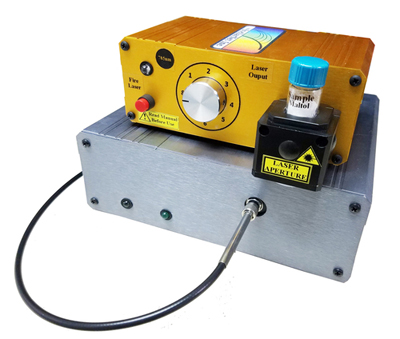
The StellarNet Raman 785-Vial System Spectrometer can be used for a variety of research, including determining the authenticity of gemstones and art work. Photo courtesy of StellarNet.
Before leaving the Winona Campus as part of the Saint Mary’s University of Minnesota’s COVID-19 policy, Nathan Lien, Ph.D., received some good news on March 18: He and his colleagues in the Department of Chemistry were one of a handful of schools to be awarded a $10,000 grant from the Pittsburgh Conference Memorial National College Program.
The acquired funding will go directly toward the purchase of a piece of state-of-the-art equipment that can be used to identify the composition of materials.
Some popular uses are to identify the authenticity of gemstones and impurities of pharmaceutical drugs, but there are a multitude of uses for the StellarNet Raman 785-Vial System Spectrometer.
“It makes us feel good that we’re doing things to improve the educational experience of our students,” said Dr. Lien, an associate professor who has been at Saint Mary’s for 10 years. “We’re providing instrumentation and experiences in the lab that other schools might not have.”
The device works by shining a laser at a piece of material. It then observes the scattering of light to determine the molecular vibrations of that material. From these vibrations, the composition of materials can be determined, Dr. Lien said.
The new equipment, which will be housed in one of the teaching labs in the Science and Learning Center, will have uses for students from first-years to seniors in courses in the spring of 2021. The new spectrometer could lead to the creation of several new chemistry experiments, such as one that Dr. Lien is most interested in exploring: an experiment detecting art forgeries.
Dr. Lien added that the equipment could also be beneficial to other research projects taking place on the Winona Campus, such as the computational research into how small molecules fit in with proteins, done by Christopher Jordan, Ph.D., assistant professor, Chemistry.
